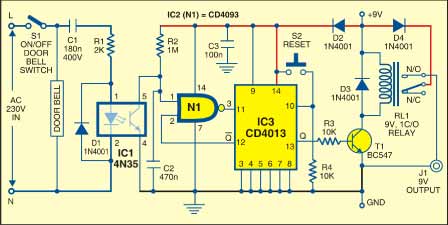One way to check whether anybody is at home is to ring the doorbell. Burglars too use this very technique. The circuit described here comes handy in such a situation. It is a simple doorbell-controlled multi-purpose security switch that instantly powers up a connected security device, say, a night-vision door camera, for functioning. The circuit works off 9V DC supply. The input of the circuit is connected in parallel with the 230V AC electric doorbell. An electromagnetic relay is used at the output of the circuit to activate the security device connected to it.
Fig. 1 shows the circuit of the doorbell-controlled security switch. Working of the circuit is simple: When somebody presses doorbell switch S1, the mains voltage is fed to the doorbell and opto-isolator IC 4N35 (IC1). The doorbell sounds and opto-isolator IC1 provides a high-to-low pulse at its pin 5 as the internal transistor conducts. Pin 5 of IC1 is connected to pin 1 of IC2, so a high-to-low pulse is also produced at pin 1 of gate N1, which triggers IC3 at pin 11. As a result, the Q output (pin 13) of IC3 goes high and the relay energises via relay-driver transistor BC547 (T1). Now the 9V DC supply becomes available at socket J1 to activate the night-vision door camera.

Note that the output socket (J1) works as a security switch and is designed for activating the 9V security device (night-vision door camera). Similarly, you can use this 9V supply to energise another switching relay in an existing home security system. The circuit can be reset by pressing switch S2.
Assemble the circuit on a general-purpose PCB and enclose in a suitable cabinet. Refer Fig. 2 for pin configurations of opto-isolator 4N35 and transistor BC547 before soldering components on the PCB. Connect the doorbell parallel to the circuit and socket J1 to the night-
vision camera.








